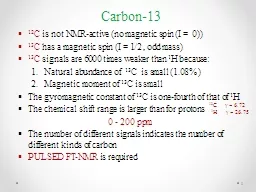/


12 C is not NMRactive no magnetic spin I 0 13 C has a magnetic spin I 12 odd mass 13 C signals are 6000 times weaker than 1 H because ID: 534975
Download Presentation The PPT/PDF document "Carbon-13" is the property of its rightful owner. Permission is granted to download and print the materials on this web site for personal, non-commercial use only, and to display it on your personal computer provided you do not modify the materials and that you retain all copyright notices contained in the materials. By downloading content from our website, you accept the terms of this agreement.
Slide1
Carbon-13
12C is not NMR-active (no magnetic spin (I = 0)) 13C has a magnetic spin (I = 1/2 , odd mass)13C signals are 6000 times weaker than 1H because:Natural abundance of 13C is small (1.08% )Magnetic moment of 13C is smallThe gyromagnetic constant of 13C is one-fourth of that of 1HThe chemical shift range is larger than for protons0 - 200 ppmThe number of different signals indicates the number of different kinds of carbonPULSED FT-NMR is required
13C g = 6.72 1H g = 26.75
1Slide2
2Slide3
Coupling Constants
However, 13C does couple to hydrogen atoms (I = 1/2)13C - 13C
coupling
NO!
not probable
very common
13
C
–
1
H
coupling
YES!
3Slide4
Coupling to attached Protons
4Slide5
Decoupling the Proton Spins
Off-resonance decoupling
Proton-Decoupled Spectra
5Slide6
Ethylphenylacetate
6Slide7
Some Instruments Show The Multiplicities of
The Peaks on The Decoupled Spectras = singlet t = tripletd = doublet q = quartetCODE :7Slide8
Hydrogen and Carbon Chemical Shifts
8Slide9
Correlation chart for
13C Chemical Shifts (ppm)9Slide10
Approximate Chemical Shift Ranges (ppm) for Selected Types of Carbon.
10Slide11
1-Propanol
11Slide12
2,2-Dimethylbutane
12Slide13
Bromocyclohexane
13Slide14
Cyclohexanol
14Slide15
Cyclohexene
15Slide16
Cyclohexanone
16Slide17
Toluene
17Slide18
a
a
b
b
c
c
1,2-Dichlorobenzene
18Slide19
1,3-Dichlorobenzene
19Slide20
Estimation of Carbon Chemical shifts in Substituted Benzene
20